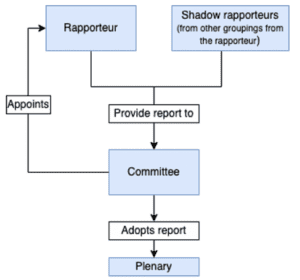2024 is a big year for democracy globally – more than half of the global population, 4 billion people are eligible to go to the ballots this year. From that 4 billion, approximately 400 million are citizens of the European Union, having the chance to participate in the 2024 European Parliamentary Elections. Yet, in the 2019 EU elections, barely more than half of the eligible electorate voted. Many were abstaining because of a certain “mysticism” surrounding the European Institutions – resulting in citizens not having enough information, and not knowing what (if any) effect their vote would have (Eurobarometer, 2019, p 63.). To dissolve this fog, let us briefly explore how exactly EU institutions – and especially, the EU Parliament – work.
Mapping policymaking
The institutions of the European Union – the European Parliament, the European Commission and the Council of the European Union (often simply referred to as “Council”) are responsible for setting up European level legislation: directives and regulations that apply to each EU country and citizen – and have effect on external relations as well. With such legislation, Member States of the EU can coordinate better, and citizens can easily collaborate beyond borders. The usefulness of such collaboration needs no introduction to the scientific community. The opportunity to travel and work hassle-free in different institutions in EU countries is a result of the EU common visa policy and the Schengen agreement, not to mention the support provided by EU wide scientific frameworks, such as Horizon Europe. And while some of these policies – such as Schengen – already became fundamental parts of our lives, others are still shaping up to their full potential – such as the new EU research Framework Programme 10, that will follow the current Horizon Programme, or the revision of the Registration, Evaluation, Authorisation and Restriction of Chemicals (REACH) regulation. These “under construction” policies, will influence your work once they enter into force – but you can, and should influence them as well. And the most straightforward way to do so is by voting.
It is, of course important to understand what exactly your vote does. But, in order to understand this, one shall have a basic overview of the interoperation of the major EU institutions. Therefore, first let’s take a step back, and look at this map (Mulder, 2021), reminiscent of a subway layout, and see how EU legislation traverses these stations.

Legislation usually begins at the European Commission, where Member State appointed Commissioners and their expert teams create legislative proposals. Then, they pass these proposals down parallelly to the the Council, consisting of ministers from member states as well as to the protagonist of this piece, the European Parliament (EP).
Who sits in the EP?
In the EP, directly elected Members of the European Parliament – MEPs – are seated: they will be decided by (hopefully) your vote, that you can cast on 6-9 June. The number of MEPs are proportional to their member countries population (degressive proportionality). However, they are not meant to represent their member countries (that is the job of the aforementioned Council), rather, work towards the betterment of the entire EU. What this betterment entails according to them though depends on their political allegiances – their parties and party groupings.
Parties & Groupings
You may be familiar with your national parties, of whom your MEP candidates are members of. However, if all elected parties would be present independently, the Parliament would be rather chaotic – even moreso than it already is sometimes. Therefore, parties get together into European party groupings. While national parties operate on the country level, and possess detailed programmes and agendas, European party groupings consist of a number of national parties from different countries, tied together by aligning ideals, operating on the European level. The European overlook provides them an opportunity to have impact on a wider scale – but as a trade-off, they are a bit more distant from the nitty-gritty of their direct electorates. Each group’s core concepts and ideas are available online, as well as the national parties they consist of.
The work of MEPs

We discussed how a legislative proposal goes to the European Parliament from the European Commission. It’s the Parliament’s job to discuss, amend and finally vote on this proposal, considering it on the EU level. But a proposal won’t immediately go to the entire Parliament. The Parliament has Parliamentary Committees consisting of MEPs who have experience or expertise in certain topics. For example, topics related to science and chemicals policy will likely end up on the desk of Committees on Environment, Public Health and Food Safety (ENVI) or on Industry, Research and Energy (ITRE). Committees nominate rapporteurs as well as shadow rapporteurs (from a party grouping different from the main rapporteur, so other parties’ perspectives are considered as well) who create reports on the Commission’s proposal. These reports can suggest amendments to the proposal, such as additions, edits or removals from the legislative texts. At the end of this process, the committee votes on the report. If accepted, this report goes to the entirety of the Parliament, who sits together in a plenary. There, they vote on these reports, prepared by Parliamentary Committees – and this vote is binding.
A practical example: R&Is future on the Horizon
To put it very briefly: the Commission comes up with ideas, but it is the Parliament who approves them, or sends them back with comments. The people decided by the elections this summer are the ones who have power to decide what legislation passes – alongside the Council. To get the full picture, it is important to know that member state ministers in the Council and the Commission also have to agree to make a legislative proposal reality. In a negotiation called trilogue, the Council – representing member state interest -, the Parliament – representing the interests of citizens on the EU level – and the Commission – initiating the legislation – have to reach an agreement, to realise the final legislation.
One of such legislative proposals, no doubt close to the hearts of many scientists, is the Framework Programme 10 (FP10), which will define the next EU research programme, set to follow Horizon Europe. After a lot of expert preparations, the details of which you can read here, the European Commission prepares the draft of the programme. The European Parliament discusses adjustments, and amends the proposal. This could include many things, such as the structure of the EU’s R&I programme, key focus areas, review mechanisms, etc., including a quite crucial part: the budget. One of the responsibilities of the Parliament is to approve how much money is allocated for the research programme – in the case of FP10, for 7 years.
The trilouge negotiations related to this also illustrate the different priorities of the different institutions. The Council focusing on member state interests, usually calls for lowering funds – as the bill is footed by member states, who try to minimise expenses. However, for the Parliament, who looks at the larger European picture, the objective is making the pan-European research initiative as successful as possible. Hence begins a back and forth, often dubbed as a “budget waltz”, where the Commission tries to find a compromise suitable for both sides. This is true not only for the research programme, but numerous initiatives, where member state and European interests may not be fully aligned. Topics related to academic integrity, sustainability, innovation and many more are on the agenda of the Parliament. And while it is clear that the Parliament is not the only actor here, it plays a crucial role in balancing out the scales – therefore choosing who will be there tasked with this job, is also an important call.
To practise your right to vote at the 2024 European Elections
Numerous members of the scientific community work in an EU country different from the one they’re citizens of. If you’re one of them, you may want to know that, in the EU elections, people can either vote for candidates from their origin countries or from their places of residence. Therefore, apart from the call for action to vote implicit in this article, I would also recommend to make a decision well in advance on where you plan to vote, in case your country of residence and your citizenship is not the same. Once this is known, you can make an informed choice by checking out available parties, their priorities and programmes – since most likely these will be the ones visible on the ballot. But it is important not to forget taking a look at the bigger picture – the party groupings that is. Check out which group your favoured party belongs to – or, vice versa, look into party groupings, identify the most ideal choice according to you, and figure out which local party is the part of that group. Practical necessities (registration requirements, voting locations, etc) differ from country to country, however comprehensive guides are available online – they are worth reading. Once all this is done, you should be ready to be on your way to the polling stations, and hopefully influence science policy – and on the larger scale, European politics itself – for the better.
Disclaimer: this article follows the structure of my presentation on this topic held at the EYCN DA in London, on 29 January 2024. You can see the related slides here.


